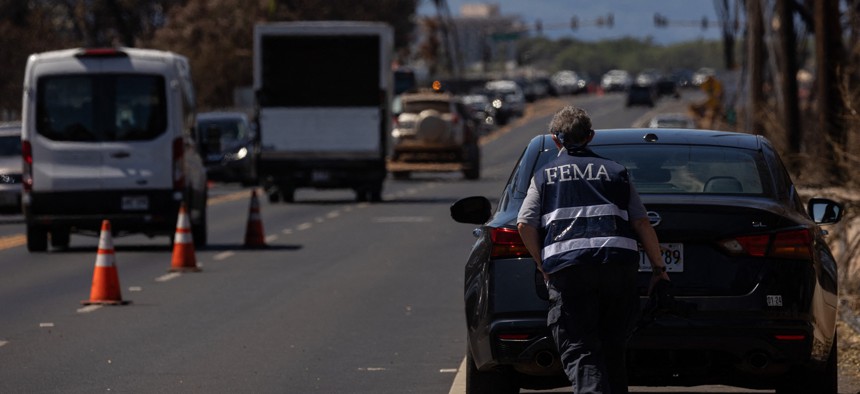
Labor Department, GSA and Hawaii state officials collaborated to deploy federally-provided identity verification options to the state’s unemployment insurance system following wildfires last month. YUKI IWAMURA / GETTY IMAGES
Hawaii’s wildfires led to fast tracking federal identity tools for unemployment claims
Hawaii is the second state after Arkansas to employ Login.gov and U.S. Postal Service identity proofing options in its unemployment insurance system.
In the wake of August’s devastating wildfires in Maui, the Labor Department, General Services Administration and Hawaii are touting the fast-tracked addition of federally-provided identity verification options to the state’s unemployment insurance system, intended to block fraudsters drawn to disaster-related benefits.
The addition of GSA’s Login.gov and in-person identity proofing at U.S. Postal Service locations to unemployment processing in Hawaii was scheduled to start in mid-September, but that timeline was pushed up to Aug. 24 because of the potential for fraud in the wake of the wildfires, according to a Hawaii Department of Labor and Industrial Relations spokesperson. The disaster unemployment assistance program started accepting applications the same day.
Hawaii is the second state to tap into these federally provided identity proofing solutions unveiled by the Labor Department in May after jobless aid systems across the nation were battered with claims submitted using stolen identity information during the pandemic — Hawaii’s own attorney general was a victim of identity fraud when her information was used to submit a Pandemic Unemployment Assistance claim.
In late August, the Labor Department estimated the improper payment rate for the Pandemic Unemployment Assistance program — a temporary, pandemic-era support program for independent contractors and others not covered by traditional jobless aid — totaled 35%. That number includes fraud and other mistakes like overpayments.
One reason that program saw such high improper payment numbers was because, at first, it was paying out money on the basis of self-certification from claimants alone.
Like the pandemic program, disaster unemployment assistance — federally funded by the Federal Emergency Management Agency — is meant for residents directly impacted by a disaster who don’t qualify for the normal unemployment program, such as those who can’t work because of injuries from the fires or whose unemployment was caused by the disaster.
Andrew Stettner, deputy director for policy in the unemployment insurance modernization office at the U.S. Department of Labor, said that Hawaii officials were concerned about an influx of claims following the fires that could also include “criminal elements that could take advantage of that moment.”
The disaster aid and COVID-era programs like PUA are more at risk for fraud because they don’t have the same checks built in as the traditional programs, said Stettner, where employers can let states know if they get a notification that a current employee is filing for unemployment, for example.
The new identity proofing screening is meant to be a long-term fixture for all types of unemployment in Hawaii, according to the state’s spokesperson.
“Identity fraud is an ongoing risk for the UI program going forward,” said Stettner.
In addition to being a drain on government money, fraudulent claims can also gum up the process for legitimate people who need unemployment assistance, according to Tamika Ledbetter, a regional administrator at the Labor Department whose scope of work includes Hawaii.
Already, the state has seen an influx in claims since the fires, with the 130 claims filed in Maui during the week of Aug. 5 jumping to over 4,440 the week of Aug. 19, according to state data.
Claimants get to choose if they want to use Login.gov or the in-person USPS option for identity proofing, said Stettner. They can also go through local claims offices, according to the state labor office.
“These new identity verification methods will help improve fraud prevention in the unemployment insurance program while ensuring eligible claimants receive benefits regardless of their location or ability to access technology,” the state’s press release on the new identity proofing options said.
“These new identity-proofing options demonstrate a successful federal-state collaboration to further ensure bad actors are prevented from receiving undue unemployment insurance benefits, helping ensure the integrity of the unemployment insurance system and expediting benefits when they’re most needed.”
Hawaii’s spokesperson said that the state went with Login.gov because of work it had been doing with the Labor Department via the agency’s tiger team initiative, where it has been sending multidisciplinary teams to states to identify problems and make recommendations for how to use grant funding.
The Labor Department team had already been doing testing and operational planning with Hawaii to put the new proofing systems in place before the fires, said Stettner, adding that the deployment has been successful so far.
“It wasn’t starting from zero, but I think that’s part of the point,” he said. The department was “able to respond in a disaster, which is just a 100% different position than we were [in] when the pandemic started.”
Resources have enabled that preparedness, said Stettner.
The Labor Department is covering the implementation and transaction costs for these identity proofing options for two years through American Rescue Plan funding, although it is subject to the availability of said funds, he said.
Congress recently slashed unemployment modernization money in half as part of the debt ceiling compromise passed in June, leaving the department with $500 million in unobligated funding. Labor requested $100 million for identity verification in the fiscal 2024 budget request, said Stettner.
More states might be adding the Login.gov and USPS identity verification options to their programs in the future — a June Labor Department blog said that “at least half” of the states have “expressed interest,” and that “the Labor Department is looking to expand to all 53 state workforce agencies.”
And in Hawaii, “we are seeing really good success with people using the validation techniques,” said Stettner.
Login.gov director Dan Lopez called the expansion of the identity verification service to Hawaii a “really early proof point in this partnership” with the Labor Department, during a Wednesday presentation at FedID 2023. Login.gov also offers a USPS in-person option, although this Labor Department collaboration with USPS on identity proofing in jobless aid is separate.
“The Department of Labor asked us to accelerate our planned launch for Login.gov in front of unemployment insurance programs in Hawaii,” he said. “We were able to do it successfully. We were also able to work with our anti-fraud team to make sure that we were tracking expected threat models that we could see in a natural disaster like the fires in Hawaii.
“This has the potential over the next couple of years to serve millions of Americans,” he said.







